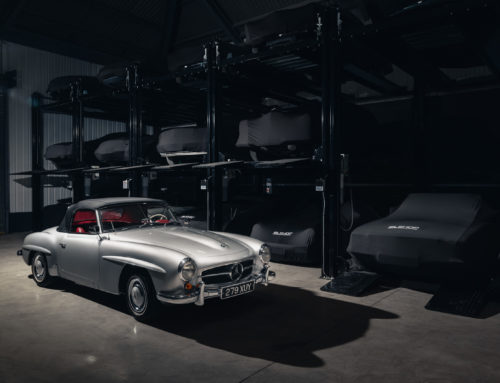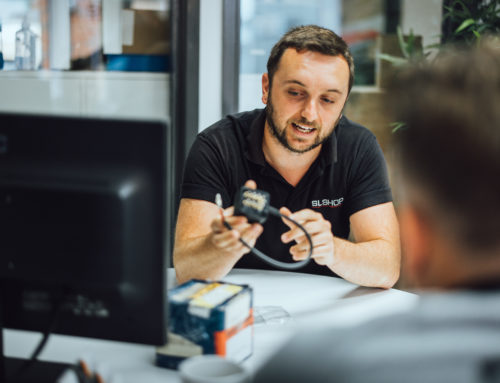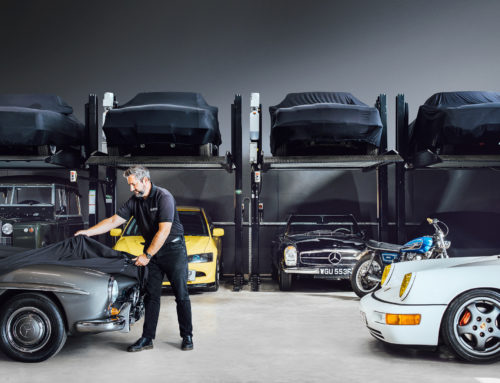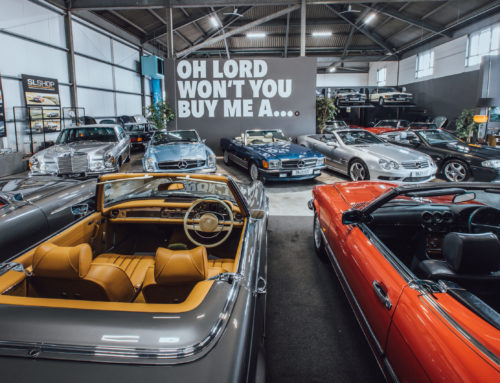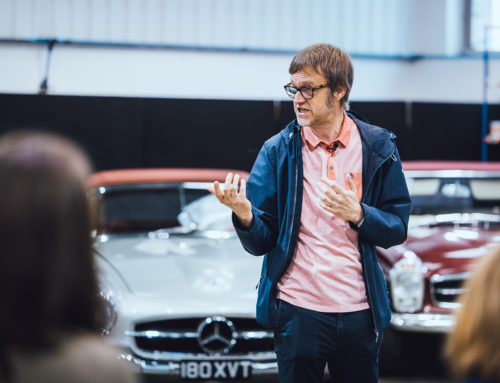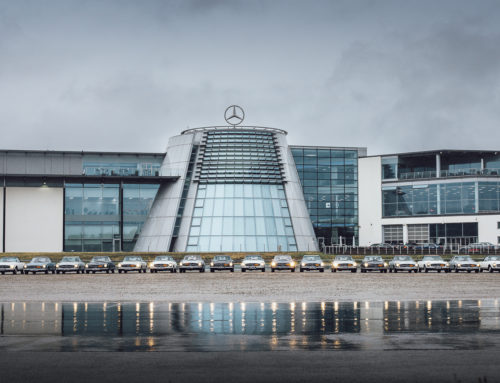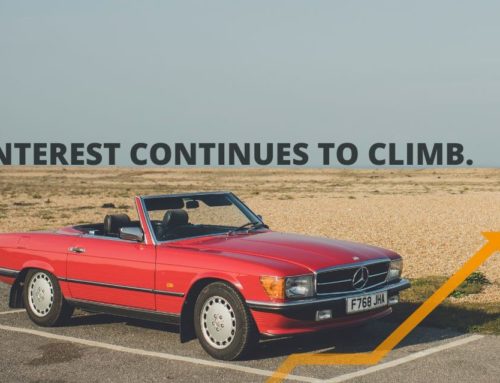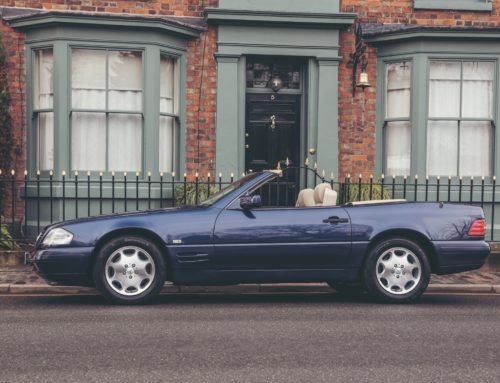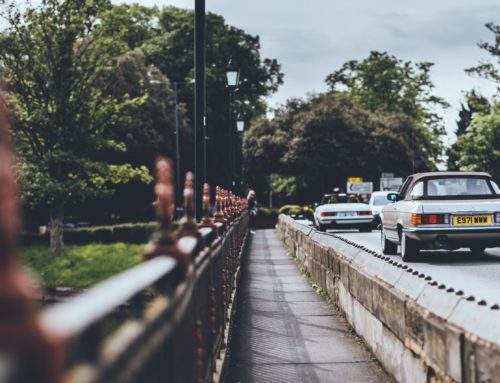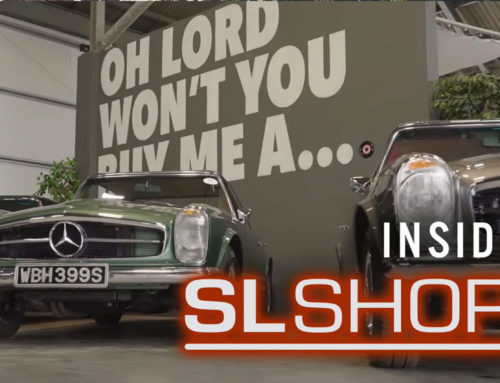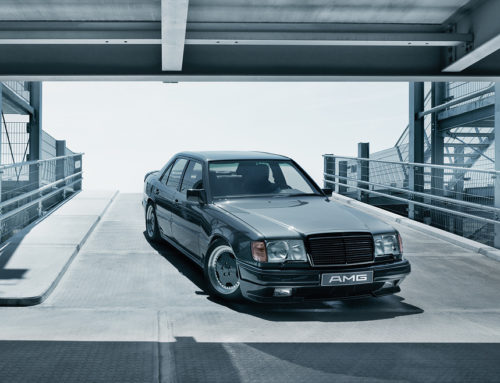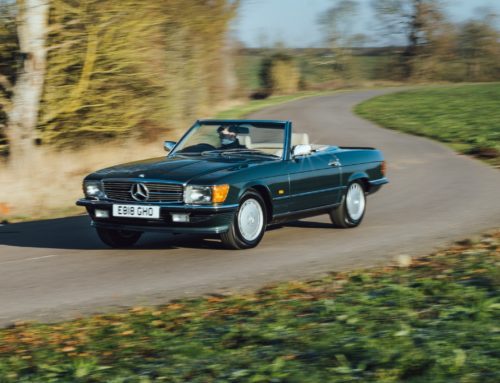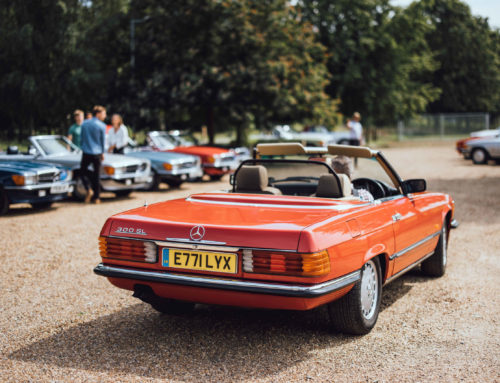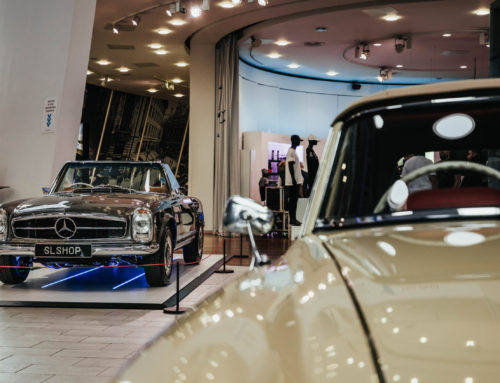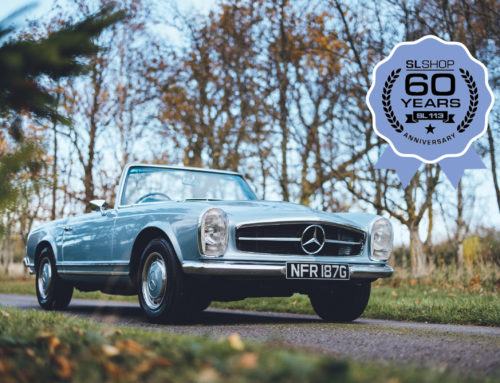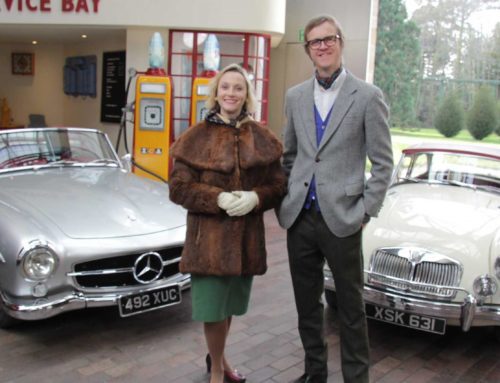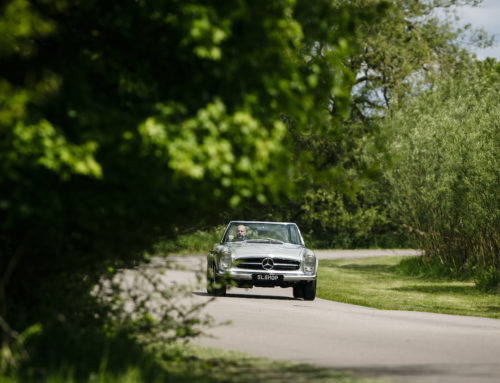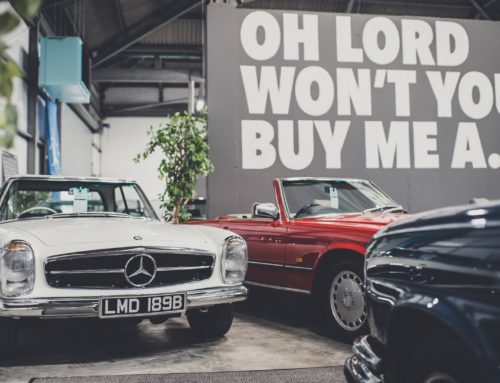Previously lacking the classic appeal of its SL stablemate, the 107-series SLC faded away, with few being looked after, but recently interest in Mercedes’ 1970s flagship couple has picked up and David Sutherland explains why it is now fashionable and sought after. Thus, begins our special section looking at Stuttgart’s classic luxury couples from 1961 until 1992.
The SLC, factory coded C107, is no longer the forgotten luxury Mercedes. But it came perilously close to extinction before rescue appeared in the form of recent, growing appreciation that the 1971 to 1981 coupe was not only an interesting – and far cheaper – alternative to the long coveted R107 SL roadster, but in some respects might even be preferable. With 62,888 built the SLC could never be judged a failure, this double the total of the preceding W111 coupe also built for 10 years, but against the R107’s 237,278 sales, albeit over an 18-year period, it looked like an underperformer.
The classic car market was not kind to the SLC when production ended. It missed out on the classic boom of the late 1980s, regarded simply as another used car heading down its depreciation curve until the cost of repairs for the annual MOT test pass saw it claimed by the breaker’s yard. While the R107 SL had been regarded as a classic ever since production ceased in 1989, a status reflected in prices, the big coupe remained unloved until about five years ago, few people willing to contemplate restoration. “We must have scrapped about 15 of them,” recalls Sam Bailey of SL Shop (01789 337070, wwww.theslshop.com), whose low mileage, 1981 280SLC you see photographed here, and offered for £39,995. This is now a normal – although not the highest – asking price for an exceptional example.
Why, after being passed over for so long, is the SLC suddenly the collectors’ hot date? First, sheer scarcity. “Too many fell by the wayside,” Sam tells us. “There are not many left, and so they are becoming really hard to find.” Second, time usually offers a new perspective on a car, and the SLC that seemed so outdated and irrelevant when replaced by the stunning C126 SEC now exudes a glow that evokes ……….(no following chapters…)
The original 1952 Sport Leicht, the 300SL, was a purpose-built sports racing car that would only ever be driven in competition but the road-going SL generation made 20 years alter is almost the last car you would choose as the basis for a circuit racer. Bulky, heavy, soft in the chassis and with six and eight-cylinder engines that prefer to spin at mid – rather than peak – revs, you would be making life difficult for yourself. In its heyday the R107 was to be seen at race meetings, but in the paddock, not on the track.
All of which was of absolutely no concern to SL Shop, which has spent the last few years developing and honing the 1978 R107 450 SL seen here into a tool for events ranging from track days to various historic racing classes. The Stratford-upon-Avon based classic Mercedes specialist was not the first to build a racing R107, that honour going to one Ian Jacobs a decade ago when he prepared and entered his eye-catching bathroom suite turquoise painted 450SL in race series for 1970s cars, but since then SL Shop boss Sam Bailey is, as far we know, the only man brave enough to take on the challenge in the UK.
“We started building it four or five years ago, it was just one of Sam’s regular R107s,” says Dan griffin, technical wizard at SL Shop. “It was a standard car and the plan was to send it off to be built into a race car.” That proved to be a false start, because what came back was not to Dan’s, Sam’s or anyone else’s liking at SL Shop, so it was decided to start again and now the only race item left from that time is the roll cage.
The engine that is now in the car is the third it has seen, and Dan says that it, with its adjustable rev limit (presently 6,500rpm), produces 270bhp at the wheels. There’s also a clamed 265lt ft torque, which as we’ll see later is at the heart of the car’s on-track character. At one stage a six-speed manual gearbox from a Toyota served, but that proved too fragile for the meaty M117 4.5-litre V8, the dent in the offside front wing made by fragments of exploding transmission evidence of that. It now has a six-speed manual box that SL Shop rustled up earlier.
Ruled Out
The rules of the race series that the 450SL can enter, such as the Advantage Motorsport Future Classics series for 1970s and 80s cars, obviously allow a lot of scope for modifications, because much about the R107 is bespoke. The engine has special manifolds, the wiring is almost completely re-done, while the thunderous engine note tells us that the one-off exhaust makes very economical use of baffling (nonetheless it’s within track day decibel limits). A Quaife limited-slip differential is fitted and chassis-wise, all the suspension has been upgraded, and is fully adjustable, and although the brakes retain standard callipers they have drilled disc and use Mintex race pads.
Unsurprisingly the car is now a very different animal to the one that arrived at SL Shop with an engine burning plenty of oil. “It’s so much better, and it’s been very reliable,” Dan comments. But he also admits that now the major work is all but done, at least for the moment, he doesn’t really want to drive it to within an inch of its life which is now its purpose. “I’ve got too much mechanical sympathy for that,” he tells us.
The driving is mainly done by Sam Baily and his son Jake, who have already entered a few races in the recently developed SL, the 19-year old in particular proving pretty effective in attacking the kerbs. But on a quiet and cold, wet Donnington Park track in early November it was time for me to take the wheel, and having known for several years that the car was being built, I was curious to say the least about how it would drive.
As is frequently the case with race cars, the first obstacle is actually gaining entry. The roll cage bars reduce access to a small slot, reduced further up by the huge, wraparound head protectors of the Sparco race seat, whose position is of course fixed in position. But after an embarrassing amount of grunting and contouring, and aided by the suede-rimmed Momo steering wheel being removable, I was squeezed in, after which the full, multi-point race harness was tightened up for me, leaving me able to breathe lightly but no more.
The interior is most un-Mercedes like, stripped bare apart from the dashboard, which now houses competition instruments, a rev counter in the centre position where the speedometer once was. There’s a plain centre console with basic switches including a master power on/off switch. No indicators, incidentally, which in this environment are clearly for wimps. The pedals are now a floor-hinged competition fixture. But the most striking impressions are the long manual gearstick jutting up, and just how low you sit, eye-level to the parked wipers.
Excuses excuses
Not wishing to have to dip into the Racing Driver’s Book of Excuses to explain why I spun into the gravel on the first corner (“a rabbit ran on to the track” is quite handy for this occasion), I decided to take things easy. But this is a car you can build confidence in quickly, not least because of the overflowing bread basket of low-down torque. When Jake said you’ll only need third and fourth gears I couldn’t see how that would work, but it does, wheelspin probably possible in third in the wet. Donnington Park near Derby is a fast, flowing circuit with no super tight hairpins, so third gear was fine for every corner, with fourth enough for the straights. The engine also sounds glorious in a way that only a V8 can when you feed in the power.
I am not a connoisseur of racing car chassis set up, but he 450SL, still on factory 14-inch ‘Mexican hat’ alloys, albeit one inch up in diameter from standard, seems very well balanced and also forging. The power steering felt normal and although my legs were folded and my feet not at the ideal angle in relation ……….(other page for end of story not visible).
Rallying point: 107-series in competition
In the 1970s the sporty Mercedes were the 107-series SL and SLC. That wasn’t saying much, the car’s bulk and weight hardly lending itself to motorsport. Nonetheless towards the end of the decade Mercedes, spurred on by legendary chief engineer Erich Waxenberger, decided to tackle top level rallying and made the 450SLC coupe its weapon of choice, entering first the standard 450SLC in 1978, and the specially built five-litre 450SLC 5.0 in 1979 and the similar 500SLC in 1979.
The results were mixed, but there were wins, aided by the sheer scale of Mercedes’ resources. In 1978’s 18,000-mile marathon Vuelta a la America del Sur, the factory fielded four cars, Andrew Cowan’s the winner, while the following year the 450SLC 5.0 filled the first four places in the Ivory Coast’s Bandama Rally. But by the end of the 1980 Stuttgart mustered a mere fourth place in the World Rally Championship constructors’ league, and for 1981, by which time SLC production was running down, opted to switch to the R107 SL roadster with its shorter wheelbase and greater agility in search of improved results.
The 1980 WRC champion Walter Rohrl was signed to drive the 500SL, carrying over the SLC’s M117 V8 in uprated form. And that was the closest the R107 ever came to a factory entry. The plan had been to campaign the R107, named the 500SL Rallye and four of which were made, as an interim measure and later switch to the forthcoming 190E 2.3-16 whose more compact size suggested much greater potential.
But then the original, turbocharged Audi Quatro happened, instantly rendering two-wheel drive rally cars uncompetitive. This led to Mercedes-Benz cancelling its WRC programme and re-focusing the hot 190E as a touring car racer. The still born 500SL Rallye has re-emerged in a Mercedes publicity role, taken by Mercedes-Benz Classic to various historic events.
Previously lacking the classic appeal of its SL stablemate, the 107-series SLC faded away, with few being looked after, but recently interest in Mercedes’ 1970s flagship couple has picked up and David Sutherland explains why it is now fashionable and sought after. Thus, begins our special section looking at Stuttgart’s classic luxury couples from 1961 until 1992.
The SLC, factory coded C107, is no longer the forgotten luxury Mercedes. But it came perilously close to extinction before rescue appeared in the form of recent, growing appreciation that the 1971 to 1981 coupe was not only an interesting – and far cheaper – alternative to the long coveted R107 SL roadster, but in some respects might even be preferable. With 62,888 built the SLC could never be judged a failure, this double the total of the preceding W111 coupe also built for 10 years, but against the R107’s 237,278 sales, albeit over an 18-year period, it looked like an underperformer.
The classic car market was not kind to the SLC when production ended. It missed out on the classic boom of the late 1980s, regarded simply as another used car heading down its depreciation curve until the cost of repairs for the annual MOT test pass saw it claimed by the breaker’s yard. While the R107 SL had been regarded as a classic ever since production ceased in 1989, a status reflected in prices, the big coupe remained unloved until about five years ago, few people willing to contemplate restoration. “We must have scrapped about 15 of them,” recalls Sam Bailey of SL Shop (01789 337070, wwww.theslshop.com), whose low mileage, 1981 280SLC you see photographed here, and offered for £39,995. This is now a normal – although not the highest – asking price for an exceptional example.
Why, after being passed over for so long, is the SLC suddenly the collectors’ hot date? First, sheer scarcity. “Too many fell by the wayside,” Sam tells us. “There are not many left, and so they are becoming really hard to find.” Second, time usually offers a new perspective on a car, and the SLC that seemed so outdated and irrelevant when replaced by the stunning C126 SEC now exudes a glow that evokes ……….(no following chapters…)
The original 1952 Sport Leicht, the 300SL, was a purpose-built sports racing car that would only ever be driven in competition but the road-going SL generation made 20 years alter is almost the last car you would choose as the basis for a circuit racer. Bulky, heavy, soft in the chassis and with six and eight-cylinder engines that prefer to spin at mid – rather than peak – revs, you would be making life difficult for yourself. In its heyday the R107 was to be seen at race meetings, but in the paddock, not on the track.
All of which was of absolutely no concern to SL Shop, which has spent the last few years developing and honing the 1978 R107 450 SL seen here into a tool for events ranging from track days to various historic racing classes. The Stratford-upon-Avon based classic Mercedes specialist was not the first to build a racing R107, that honour going to one Ian Jacobs a decade ago when he prepared and entered his eye-catching bathroom suite turquoise painted 450SL in race series for 1970s cars, but since then SL Shop boss Sam Bailey is, as far we know, the only man brave enough to take on the challenge in the UK.
“We started building it four or five years ago, it was just one of Sam’s regular R107s,” says Dan griffin, technical wizard at SL Shop. “It was a standard car and the plan was to send it off to be built into a race car.” That proved to be a false start, because what came back was not to Dan’s, Sam’s or anyone else’s liking at SL Shop, so it was decided to start again and now the only race item left from that time is the roll cage.
The engine that is now in the car is the third it has seen, and Dan says that it, with its adjustable rev limit (presently 6,500rpm), produces 270bhp at the wheels. There’s also a clamed 265lt ft torque, which as we’ll see later is at the heart of the car’s on-track character. At one stage a six-speed manual gearbox from a Toyota served, but that proved too fragile for the meaty M117 4.5-litre V8, the dent in the offside front wing made by fragments of exploding transmission evidence of that. It now has a six-speed manual box that SL Shop rustled up earlier.
Ruled Out
The rules of the race series that the 450SL can enter, such as the Advantage Motorsport Future Classics series for 1970s and 80s cars, obviously allow a lot of scope for modifications, because much about the R107 is bespoke. The engine has special manifolds, the wiring is almost completely re-done, while the thunderous engine note tells us that the one-off exhaust makes very economical use of baffling (nonetheless it’s within track day decibel limits). A Quaife limited-slip differential is fitted and chassis-wise, all the suspension has been upgraded, and is fully adjustable, and although the brakes retain standard callipers they have drilled disc and use Mintex race pads.
Unsurprisingly the car is now a very different animal to the one that arrived at SL Shop with an engine burning plenty of oil. “It’s so much better, and it’s been very reliable,” Dan comments. But he also admits that now the major work is all but done, at least for the moment, he doesn’t really want to drive it to within an inch of its life which is now its purpose. “I’ve got too much mechanical sympathy for that,” he tells us.
The driving is mainly done by Sam Baily and his son Jake, who have already entered a few races in the recently developed SL, the 19-year old in particular proving pretty effective in attacking the kerbs. But on a quiet and cold, wet Donnington Park track in early November it was time for me to take the wheel, and having known for several years that the car was being built, I was curious to say the least about how it would drive.
As is frequently the case with race cars, the first obstacle is actually gaining entry. The roll cage bars reduce access to a small slot, reduced further up by the huge, wraparound head protectors of the Sparco race seat, whose position is of course fixed in position. But after an embarrassing amount of grunting and contouring, and aided by the suede-rimmed Momo steering wheel being removable, I was squeezed in, after which the full, multi-point race harness was tightened up for me, leaving me able to breathe lightly but no more.
The interior is most un-Mercedes like, stripped bare apart from the dashboard, which now houses competition instruments, a rev counter in the centre position where the speedometer once was. There’s a plain centre console with basic switches including a master power on/off switch. No indicators, incidentally, which in this environment are clearly for wimps. The pedals are now a floor-hinged competition fixture. But the most striking impressions are the long manual gearstick jutting up, and just how low you sit, eye-level to the parked wipers.
Excuses excuses
Not wishing to have to dip into the Racing Driver’s Book of Excuses to explain why I spun into the gravel on the first corner (“a rabbit ran on to the track” is quite handy for this occasion), I decided to take things easy. But this is a car you can build confidence in quickly, not least because of the overflowing bread basket of low-down torque. When Jake said you’ll only need third and fourth gears I couldn’t see how that would work, but it does, wheelspin probably possible in third in the wet. Donnington Park near Derby is a fast, flowing circuit with no super tight hairpins, so third gear was fine for every corner, with fourth enough for the straights. The engine also sounds glorious in a way that only a V8 can when you feed in the power.
I am not a connoisseur of racing car chassis set up, but he 450SL, still on factory 14-inch ‘Mexican hat’ alloys, albeit one inch up in diameter from standard, seems very well balanced and also forging. The power steering felt normal and although my legs were folded and my feet not at the ideal angle in relation ……….(other page for end of story not visible).
Rallying point: 107-series in competition
In the 1970s the sporty Mercedes were the 107-series SL and SLC. That wasn’t saying much, the car’s bulk and weight hardly lending itself to motorsport. Nonetheless towards the end of the decade Mercedes, spurred on by legendary chief engineer Erich Waxenberger, decided to tackle top level rallying and made the 450SLC coupe its weapon of choice, entering first the standard 450SLC in 1978, and the specially built five-litre 450SLC 5.0 in 1979 and the similar 500SLC in 1979.
The results were mixed, but there were wins, aided by the sheer scale of Mercedes’ resources. In 1978’s 18,000-mile marathon Vuelta a la America del Sur, the factory fielded four cars, Andrew Cowan’s the winner, while the following year the 450SLC 5.0 filled the first four places in the Ivory Coast’s Bandama Rally. But by the end of the 1980 Stuttgart mustered a mere fourth place in the World Rally Championship constructors’ league, and for 1981, by which time SLC production was running down, opted to switch to the R107 SL roadster with its shorter wheelbase and greater agility in search of improved results.
The 1980 WRC champion Walter Rohrl was signed to drive the 500SL, carrying over the SLC’s M117 V8 in uprated form. And that was the closest the R107 ever came to a factory entry. The plan had been to campaign the R107, named the 500SL Rallye and four of which were made, as an interim measure and later switch to the forthcoming 190E 2.3-16 whose more compact size suggested much greater potential.
But then the original, turbocharged Audi Quatro happened, instantly rendering two-wheel drive rally cars uncompetitive. This led to Mercedes-Benz cancelling its WRC programme and re-focusing the hot 190E as a touring car racer. The still born 500SL Rallye has re-emerged in a Mercedes publicity role, taken by Mercedes-Benz Classic to various historic events.
More from Journal
CARE
THE ULTIMATE CERTIFIED SERVICING INVESTMENT PLAN
Your ownership journey matters to us, which is why we have created a simple certified servicing investment plan, tailored to your individual needs and aspirations.
Start investing today and our dedicated CARE team will work with you to increase the value and enjoyment you receive from your vehicle.

STAY IN TUNE WITH SLSHOP MOMENTS
As part of SLSHOP’s community of enthusiasts, you’ll be the first to hear about events and tours, key product offers, exciting stories from owners around the world and of course… our latest additions to the showroom. So, be the first to know and you might just sneak a car on your driveway or take your car’s condition to new heights with our exclusive replacement parts.
Or, visit SLSHOP Journal



